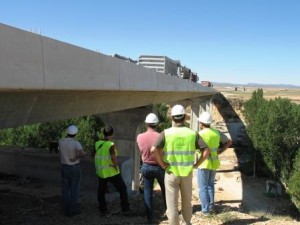 Acaban de publicarnos un artículo muy novedoso sobre la aproximación cognitiva a los problemas de optimización multiobjetivo de las estructuras de hormigón. La revista es Archives of Civil and Mechanical Engineering, que es una revista de alto impacto en el campo de la ingeniería civil, indexada en el JCR en el primer cuartil. El resultado de combinar técnicas de decisión multicriterio junto con la optimización multiobjetivo supone una auténtica revolución en la forma de abordar el diseño de las estructuras. Ya no basta con aplicar la experiencia, la imaginación y las normas para proyectar una estructura. Se hace necesario abordar el problema desde el origen, considerando múltiples perspectivas y buscando soluciones que optimicen a la vez aspectos como los costes, la seguridad, la sostenibilidad, los riesgos laborales, la durabilidad, la estética y tantos otros.
Acaban de publicarnos un artículo muy novedoso sobre la aproximación cognitiva a los problemas de optimización multiobjetivo de las estructuras de hormigón. La revista es Archives of Civil and Mechanical Engineering, que es una revista de alto impacto en el campo de la ingeniería civil, indexada en el JCR en el primer cuartil. El resultado de combinar técnicas de decisión multicriterio junto con la optimización multiobjetivo supone una auténtica revolución en la forma de abordar el diseño de las estructuras. Ya no basta con aplicar la experiencia, la imaginación y las normas para proyectar una estructura. Se hace necesario abordar el problema desde el origen, considerando múltiples perspectivas y buscando soluciones que optimicen a la vez aspectos como los costes, la seguridad, la sostenibilidad, los riesgos laborales, la durabilidad, la estética y tantos otros.
El artículo plantea la metodología básica necesaria para establecer la resolución de este tipo de problemas. Sin embargo se deben potenciar los estudios que permitan valorar los aspectos más subjetivos que intervienen en la decisión de la mejor opción de las posibles. Esta línea de investigación se encuadra dentro del proyecto de investigación BRIDLIFE, del cual soy investigador principal. Además, supone un ejemplo de colaboración con otras universidades, en este caso con la Universidad de Zaragoza.
Referencia:
YEPES, V.; GARCÍA-SEGURA, T.; MORENO-JIMÉNEZ, J.M. (2015). A cognitive approach for the multi-objective optimization of RC structural problems. Archives of Civil and Mechanical Engineering, 15(4):1024-1036. doi:10.1016/j.acme.2015.05.001
Abstract:
This paper proposes a cognitive approach for analyzing and reducing the Pareto optimal set for multi-objective optimization (MOO) of structural problems by means of jointly incorporating subjective and objective aspects. The approach provides improved knowledge on the decision-making process and makes it possible for the actors involved in the resolution process and its integrated systems to learn from the experience. The methodology consists of four steps: (i) the construction of the Pareto set using MOO models; (ii) the filtering of the Pareto set by compromise programming methods; (iii) the selection of the preferred solutions, utilizing the relative importance of criteria and the Analytic Hierarchy Process (AHP); (iv) the extraction of the relevant knowledge derived from the resolution process. A case study on the reinforced concrete (RC) I-beam has been included to illustrate the methodology. The compromise solutions are obtained through the objectives of economic feasibility, structural safety, and environmental sustainability criteria. The approach further identifies the patterns of behavior and critical points of the resolution process which reflect the relevant knowledge derived from the cognitive perspective. Results indicated that the solutions selected increased the number of years of service life. The procedure produced durable and ecological structures without price trade-offs.
